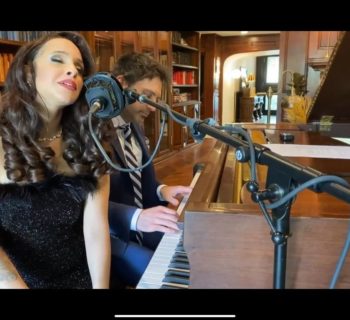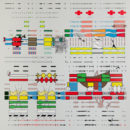What follows are 14 tips to help you improve your pitching game. Bobby Borg and Michael Eames, co-authors of the new book Introduction to Music Publishing for Musicians, discuss everything from making sure your music is really ready to pitch, to having an attorney available who can help. There are a lot of tips to take in, so grab that yellow highlighter pen, and let’s get to work.
1: Make Sure Your Music is Really Ready to Pitch
Before sending out your music to all those amazing places, it’s crucial that you make sure your songs are truly ready to impress—this is the first step in pitching like a pro.
There’s more than one way to write a great song, as you already know, but you should at least consider the following:
•Structure: Are your songs’ intros short? Do you get to the chorus quickly? And is there distinction between all of the parts of your songs?
•Lyrics: Are your lyrics clear, vivid, and unique? Do they speak to your target audience? And are they broad enough so that you are not painting yourself into a corner? (Remember that specificity is good for some things, but not good for film/TV/game placements since it limits the ways a song can be used.) And finally…
•Melody: Can your songs be easily hummed back after hearing them just once?
While it is understandable for artists to think that everything they write is the most amazing thing on earth, just be sure to get feedback from consultants, writing teachers, and even your target audience before starting to pitch them to various music users and industry people.
Overall, by making sure your songs are in tip-top shape, you will make the entire pitching process so much easier for everyone involved. You’ll be putting your best foot first.
2: Make Sure Your Recordings Are Broadcast Quality
After making sure you really have great material, the second step in pitching like a pro involves making sure that your recordings are broadcast quality. Consider the following few points:
•Sound: Do the instruments sound current? Did you use the best microphones when recording? And are there any unnecessary hums from electronic gear such as amps?
•Performance: Do the vocals capture the true emotion of the lyric? Is the drummer in time throughout the entire song? And do all the instruments and vocals stay in tune? And finally…
•Pro Quality: Do your recordings sound great when referenced against professionally recorded tracks? Could you imagine your record playing seamlessly between two songs on a major commercial radio station? Or would you be embarrassed hearing your recording on a popular playlist on Spotify?
Forget about the old saying, “You can hear a hit through the shit.” These days, with all of the home recording gear that exists, crappy recordings only point to your laziness. So make every effort to get this part of the pitching process right. You’ll be glad you did.
3: Prepare Different Types of Mixes
Now that you’re sure your recordings are broadcast quality, the third step in pitching like a pro deals with preparing different mixes of your song. Remember, the more mixes, the more opportunities.
Mixes might include the following:
•Regular Vocal Mix: This is your typical mix that includes all of the instruments and the vocalist for release on radio, playlists, and more.
•Instrumental Mix: This is where you leave the vocals out so that film and TV editors can more easily cut around dialogue in a film.
•TV Mix: This is where the main vocal track is muted but the background vocals (i.e. oohs, aahs, heys, etc.) are left in for potential performances you might do on television.
•Clean Mix: This is where profanities are bleeped out to adhere to TV networks’ “standards and practices” and to adhere to certain broadcast rules for radio and TV.
•Vocal Down Mix: This is where the vocal track is lowered so that it does not compete with the dialogue in a film or TV show. And finally…
•Recorded Stems: This is where you keep individual audio tracks (WAV or AIF files) that comprise your recording available so movie trailer editors can do their own mixes to fit their needs.
As you can see, the more mixes you have, the more situations you can accommodate. And the more situations you can accommodate, the easier the pitching process will be.
4: Make Sure You’ve Cleared Any Samples/Interpolations
Moving on to the fourth tip in pitching like a pro, it’s time to discuss samples and interpolations.
As you already know, sampling is when you use a piece from another artist’s sound recording. Interpolating is when you rerecord a small part of a song.
In either case, assuming you are not using a service like Splice or Apple Loops that have taken care of all the legalities for you, remember that both samples (the song and the master) and interpolations (the song) must be “cleared” (i.e., you must get permission from the copyright owner or his/her representatives) and pay either a negotiated fee and/or give up a percentage of ownership in your new work.
While clearing samples and interpolations could be a whole chapter in and of itself, it generally can be done by reaching out directly to the publisher(s) or master owner(s) of the song you’re sampling/interpolating, or by hiring an actual “clearing house” to do this for you. Failure to get clearance will make it hard to pitch and license your song and it could even lead to copyright infringement.
If you can avoid using samples or interpolations, we recommend it. The more samples and interpolations you use, the harder it is to license your music. So focus on creating your beats and tracks and be a far better pitcher.
Afterthought: 7K for just 1/4 of the song:
I (this is Bobby speaking) knew one independent artist who was asked to pay $7,500 to Universal Music Publishing Group for the use of just one sample from a song, and note that Universal was just a 1/4 owner in the song, which meant that he would have ended up paying $30K total. That’s far too much for a DIY artist to pay.
5: Have Your Split Sheets Together
At over 1/3 of the way through our 14 tips on pitching like a pro, also be sure to get all of your co-writer splits agreed upon (assuming that you have any co-writers). This is very important!
Just remember that anyone wanting to license your music will want reassurance that there will be no disagreements in the future between the writers.
As discussed previously, the form typically used to record splits between writers is called a “split sheet.” We offer a sample in Chapter One of our book, but just in case, a proper split sheet includes the following:
•Date: The date on which the song was completed.
•Names: Full names of all writers as they are used legally.
•PRO Affiliation: All writers’ PRO affiliations and IPI numbers (the unique number that is assigned to you when you join any PRO).
•Publishing Company Name: All writers’ publishing company names.
•Song Percentages: The writer and publisher splits.
•Master Percentages: The master owner(s) and splits. And finally…
•Signatures: The signatures of each writer acknowledging the splits.
While U.S. copyright law assumes that collaborators split songs (and masters) equally based on the number of creators involved, collaborators often have different ideas about how they want to split up the rights. So make no mistake, a split sheet is essential in preparing to pitch like a pro and assuring music users that you have taken care of your business.
6: List The Proper MetaData
Now that you have all of your co-writers splits decided on, the sixth step in pitching like a pro involves making sure that your songs are tagged with the proper metadata (i.e., information about writers, release dates, and more).
Metadata is not only helpful in ensuring that your music will be properly stored, sorted and identified everywhere that it is distributed, it will ensure that your music is identifiable when it comes time to receiving royalties too.
The most basic metadata required by digital distributors of music includes:
•Song title
•Artist name
•Label name
•Songwriters
•Timing of the song
•Release date of the song
•Genre, and…
•Industry Standard Recording Code (ISRC), which is like your song’s social security number you get from your distributor or by contacting usisrc.org
Other metadata required by people to whom you will be pitching your music includes:
•Contact information
•Subject matter of the song
•Mood of the song
•Instrumentation of the song
•Like-artists (artists you sound like)
•BPM (beats per minute), and…
•Full lyrics (which is helpful for keyword searches)
Don’t underestimate the importance of metadata, folks. As said by the staff at Landr (a digital mastering company), failure to add the proper metadata is like sending your music to the airport with no passport, no boarding pass, no money and no neck pillow. It’s not going to reach its destination without a lot of confusion and stress. And it will be harder to get you paid, as well.
Getting your metadata right is a crucial step in the pitching process, so just do it! And do it right away when finishing your track. It’s hard to go back and do it later. Okay? Good!
Metadata is typically stored in MP3 files in fields that can be found in, for example, iTunes software.
To enter basic metadata (such as your artist name, release date, and genre), open the iTunes software, select a song, and choose "Get Info." A window will open with a bunch of different fields called "ID3 tags." Then enter data.
To enter more detailed metadata (such as the subject of the song, the mood of the song, and the BPM of the song), look for the "Comments" or "Grouping" fields. Then enter the data.
Note: There are software systems that simplify the metadata process by providing extra metadata fields. The two most used are Disco and SourceAudio.
7: Get Ready to “Show That You Know” Your Music Well
Moving on to the seventh tip of our 14 tips in pitching like a pro (yes, we’re halfway home), it’s time to talk about showing that you understand the special characteristics of your music.
This will help you to better respond to requests from music users and will help you to make wiser suggestions to various song pluggers about how you see your music serving them.
Here are a few things you should always know:
•Genre: The genre (and even sub-genre) of your song
•Like Artists: The artists you sound most like
•Subject Matter: Your song’s subject matter
•Mood: The mood of your music (happy, sad, chill, etc.), and…
•Use: Specific scenes and plot lines in which your song could be used
Take it from us—the more you know, the faster your business will grow. After all, if you don’t know what your music is and how it benefits music users, don’t expect others to figure it out for you. If you want to pitch like a pro, you have to be in the know. So do your homework today.
8: Know the People You Are Pitching
Tip number eight on pitching like a pro involves knowing the persons that you are pitching to.
If you are fortunate enough to get the opportunity to pitch a music supervisor you admire, be sure to know what he/she is currently working on, what songs he/she has used in the past on a particular project, and how your music can serve his/her current projects.
To conduct your research, use resources like IMDB, Tunefind, What-Song.com, and the “Film & Television Music Monthly,” offered by the folks at the Music Business Registry (more on them in a minute).
Look gang, whether it is a music supervisor, an A&R rep, or a song plugger, the more knowledgeable you appear about the person you are pitching to, the more impressed the person will be with you, and thus the more effective you will be in the pitching process. Enough said!
9: Know the Best Way to Make Contact
Dovetailing nicely from knowing the people you are pitching, our eighth tip in pitching like a pro deals with knowing the best way to make contact with these people.
Two resources (“Film and TV Music Guide,” and “Music Publishers Guide”) offered by The Music Business Registry at musicregistry.com, provide the phone numbers, emails, and addresses of nearly every music licensing professional. [Music Connection, as well, publishes an annual Directory of Music Supervisors, free on its website.]
But before firing off emails to literally every industry professional on the face of the earth, find out how people prefer to be contacted (check the guides or the websites of the companies you want to contact).
If no contact preference is listed, use email as the default. Email tends to be the most effective way to initially reach out to someone you haven’t already met as it allows them to respond when their schedule permits. Though phone calls can be effective, if you happen to get someone on the phone while they are busy or distracted it can be an awkward first way of communicating with someone.
So for the absolute sake of clarity, we will repeat: get the preferred method of contact for industry persons you are trying to pitch and resort to email as the default mode. Okay? Good!
10: Communicate Like a True Professional
Now that you’ve got the preferred method of contact for industry persons in hand, you still need to know how to communicate with him/her like a pitching pro. Welcome to tip number ten.
Communicating like a true professional generally can be summed up as follows: be succinct, be clear about your intent, and be respectful of your contact’s time.
To illustrate, an email might say:
“Hi Mr. X, I’m John Doe from a local electronic pop group named Flex. I see that you’re supervising my favorite new TV show and that you’ve used two bands that actually sound quite similar to us. Please find a link to our latest EP where you can stream and download four songs that I feel would work perfectly for the show. I have included all the relevant metadata in the files together with my contact. It would be a great honor to work with you. Thank you.”
That’s all you need gang! Notice that in these five short sentences John Doe has:
•Introduced his band and his band’s genre
•Indicated he has done his research and knows what the supervisor is working on
•Showed that his music is a good fit with the type/style of music they already use
•Indicated he knows how to prepare files with metadata and can easily be contacted
•Provided a link to his music, and…
•Showed respect by being both humble and grateful.
Follow these tips and you will find yourself pitching like a pro. It is that simple you guys. The idea is to keep your communications as effortless and pleasant as possible. Okay? Good!
Afterthought: Befriend the Gatekeeper
If you end up calling someone instead of emailing them and you get an assistant to the person you are trying to reach, be concise, personable and extremely polite. Assistants can end up being huge allies for you. Not only that, today’s assistants might be tomorrow’s executives.
11: Know How to Send Your Music
Keeping with our scenario between Mr. X and John Doe above, our 11th tip in pitching like a pro emphasizes the importance of knowing how to send your music to industry persons.
Did you notice how John Doe (above) included a link to his music, rather than attaching an MP3? This is because MP3s take up space in a person’s email inbox and on their hard drives.
Doe’s music actually linked to a great service called Disco (disco.ac) where his music can be streamed and downloaded. There are other great services you can use too including:
•SourceAudio (sourceaudio.com)
•Soundcloud (soundcloud.com)
•Box (box.com)
•Dropbox (dropbox.com)
•SynchTank (synchtank.com), and…
•Songspace (songspace.com)
These sites all provide both streaming and downloading, and even provide analytics about who listened to your songs, how long they listened, and what tracks they downloaded.
Tools like these take time to set up and refine (and they also cost money), but they can eventually make the pitching process effortless. Be sure to check out these tools today.
What If No Fee Is Offered Upfront to Use My Song?
If a licensing opportunity involves no up front fee, here are two things to explore:
•Credit or Promotion: Explore the possibility of getting credit in the end titles of the project, having them put a link to your song on their website, and/or giving you permission to use portions of the film (if it’s an indie film project, for instance) in your upcoming music video.
•Step Deals: Explore the possibility of getting paid in “steps” (particularly when working on a low-budget indie film). Step one might involve giving the rights to your music for free while the director is showing the film at festivals. Step two might involve getting a fee when the director is signing a distribution deal. And step three might involve getting additional payments as the director is experiencing sales at theater box offices.
So as you can see, even when licensing your music for free, you still have to know the business and know your place in it too. After all, you are a pro and not just a hobbyist.
12: Be Prepared to Follow Up
Moving on to tip number 12 of pitching like a pro, you should know about a great saying that can’t be more relevant to our discussion: “Follow up or fail.” Bottom line, just sending an email or leaving a phone message for a business industry professional and praying for a response will get you nowhere. You have to at least be able to do the seven tips below if you want to be successful:
•Make your first communication utilizing the skills you learned above.
•Make a second communication one week later reminding the person who you are.
•Make a third communication two weeks after the second communication.
•Make one final communication two weeks after the third communication.
•Always remain extremely polite and show that you are respectful of their time.
•Never show any signs of getting frustrated, annoyed, hopeless, or depressed. (Remember that no one owes you anything, no matter how good you are.) And…
•Don’t worry if you never receive a response. You can try again in the future when you have more to offer and are more successful.
Remember, pitching is an art. You have to learn how to play the game and you have to learn to play the game well. The more you do it, the better you’ll get at it.
13: Understand the Business and Know Your Place In It
As we are approaching the end of our 14 tips on pitching like a pro, let us remind you about some of the more legal stuff that we’ve been talking about in earlier chapters of this book.
Should you be successful enough that people are interested in discussing placement opportunities or deals with you, you have to show that you’re competent in the following areas:
•Song copyrights
•Sound recording copyrights
•Synch negotiations (context, timing, territory, media, duration, and price)
•Recording contracts
•Publishing contracts, and…
•Standard music industry policies and practices
It is crucial that you understand what is fair and ordinary while also understanding what your own worth is too. This comes with experience, but it also comes with checking out additional resources like Music, Money, and Success by Jeff and Todd Brabec, and it sometimes comes from entering into several deals early on where you get no upfront pay at all (particularly in music licensing situations like small films and TV placements).
On the latter note, be sure to check out the boxed text below before moving on to our final tip on attorneys.
14: Have an Attorney Available Who Can Help
And finally, for our 14th and last tip on pitching like a pro, it is important that you find an experienced entertainment attorney who understands music publishing. As they say, a man who is his own attorney just may have a fool for a client.
The best way to find an attorney is through referrals from people you trust. But just remember that attorneys are not cheap (reviewing a simple synch deal could cost $300 per hour).
Sometimes a music business consultant who truly understands the business could be a more affordable substitute for an attorney—especially in cases when there is not a lot of money being offered for your songs and/or when the risk of loss is extremely low (like when the deal is a non-exclusive deal, there is no ownership transfer involved, or the deal is for a short term).
Free services may also be available to you. For instance, The University of California Los Angeles has the Music Industry Clinic where they provide free help to rising musicians and bands. There is also the Indie Artist Resource, which provides free templates.
But whomever you get to assist you, just be sure you get someone who is highly recommended. And don’t be a cheap-ass either. If you are making $2,500 on a synch deal, you can afford to hire someone. You get what you pay for.
Okay! So now that you know how to pitch like a pro, you should really be ready to start sending out your music to all of those wonderful places discussed in previous chapters. Are you excited?! We hope so. On that note, happy pitching! You can now start hitting the send button. •
Bobby Borg, MCM is a former recording/touring artist, the founder of Bobby Borg Consulting, and the author of Music Marketing For The DIY Musician and Business Basics For Musicians. He is also an adjunct professor of Music Industry studies at USC’s Thornton School of Music.
Michael Eames is a trained composer, songwriter and pianist with experience in film scoring, the President and co-Founder of PEN Music Group, Inc., and an advisor to the Independent Publisher Advisory Council (IPAC) of the National Music Publisher’s Association (NMPA).













